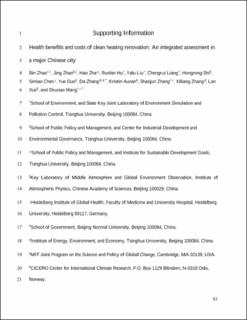| dc.contributor.author | Zhao, Bin | |
| dc.contributor.author | Zhao, Jing | |
| dc.contributor.author | Zha, Hao | |
| dc.contributor.author | Hu, Ruolan | |
| dc.contributor.author | Liu, Yalu | |
| dc.contributor.author | Liang, Chengrui | |
| dc.contributor.author | Shi, Hongrong | |
| dc.contributor.author | Chen, Simiao | |
| dc.contributor.author | Guo, Yue | |
| dc.contributor.author | Zhang, Da | |
| dc.contributor.author | Aunan, Kristin | |
| dc.contributor.author | Zhang, Shaojun | |
| dc.contributor.author | Zhang, Xiliang | |
| dc.contributor.author | Xue, Lan | |
| dc.contributor.author | Wang, Shuxiao | |
| dc.coverage.spatial | China | en_US |
| dc.date.accessioned | 2021-10-08T10:59:30Z | |
| dc.date.available | 2021-10-08T10:59:30Z | |
| dc.date.created | 2021-09-24T16:09:15Z | |
| dc.date.issued | 2021 | |
| dc.identifier.citation | Environmental Science and Technology. 2021, 55 (14), 10046-10055. | en_US |
| dc.identifier.issn | 0013-936X | |
| dc.identifier.uri | https://hdl.handle.net/11250/2788696 | |
| dc.description.abstract | China has been promoting one of the world’s largest campaigns for clean heating renovation since 2017. Here, we present an integrated cost–benefit analysis in a major prefecture-level city by combining a large-scale household energy survey and PM2.5 exposure measurement, high-resolution chemical transport simulation, and health impact assessment. We find that the completed renovation decreases the share of solid fuels in the heating energy mix from 96 to 6% and achieves a concomitant reduction of cooking solid-fuel use by 70%. The completed renovation decreases the ambient PM2.5 concentration in Linfen by 0.5–5 μg m–3 (2.4 μg m–3 on average) and decreases the integrated PM2.5 exposure by 4.2 (3.5–5.0) μg m–3. The renovation is estimated to avoid 162 (125–225) and 328 (254–457) premature deaths annually based on two health impact assessment methods. The ratios of monetized health benefits to cost are 1.51 (0.73–2.59) and 3.06 (1.49–5.23) based on the above two methods. The benefit-to-cost ratio is projected to remain high if the renovation is further expanded. More polluted and less wealthy households enjoy larger health benefits but also experience a higher expense increase, suggesting that a more carefully designed subsidy policy is needed to protect low-income households. | en_US |
| dc.language.iso | eng | en_US |
| dc.publisher | ACS Publication | en_US |
| dc.subject | clean heating renovation | en_US |
| dc.subject | cost−benefit analysis | en_US |
| dc.subject | household air pollution | en_US |
| dc.subject | PM2.5 | en_US |
| dc.subject | household energy survey | en_US |
| dc.title | Health Benefits and Costs of Clean Heating Renovation: An Integrated Assessment in a Major Chinese City | en_US |
| dc.type | Journal article | en_US |
| dc.type | Peer reviewed | en_US |
| dc.description.version | submittedVersion | en_US |
| dc.source.pagenumber | 10046-10055 | en_US |
| dc.source.volume | 55 | en_US |
| dc.source.journal | Environmental Science and Technology | en_US |
| dc.source.issue | 14 | en_US |
| dc.identifier.doi | 10.1021/acs.est.1c00930 | |
| dc.identifier.cristin | 1938414 | |
| cristin.ispublished | true | |
| cristin.fulltext | preprint | |
| cristin.qualitycode | 2 | |
